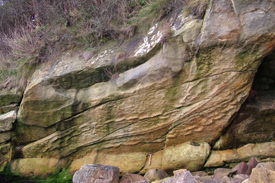 Geologist
Martin Whyte of the University of Sheffield in the United Kingdom was strolling
along a rocky beach in Scotland, when he came upon a stretch of sandstone with
some odd-looking indentations. As soon as he saw it, “I knew that [the
indentations] had been made by an animal and that it was big,” Whyte says.
A quick examination revealed that the trackway (shown in photo at left, traversing
the rock formation) had been made by an animal using six legs, and therefore
could not have been made by a mammal, amphibian or reptile.
Geologist
Martin Whyte of the University of Sheffield in the United Kingdom was strolling
along a rocky beach in Scotland, when he came upon a stretch of sandstone with
some odd-looking indentations. As soon as he saw it, “I knew that [the
indentations] had been made by an animal and that it was big,” Whyte says.
A quick examination revealed that the trackway (shown in photo at left, traversing
the rock formation) had been made by an animal using six legs, and therefore
could not have been made by a mammal, amphibian or reptile. Whyte reported in the Dec. 1 Nature that a man-sized walking water scorpion, or eurypterid, created the 1- by 6-meter trackway some 330 million years ago. Most eurypterids were about 10 to 20 centimeters in length and lived in the water. This specimen, Hibbertopterus, was about 1 by 1.6 meters.
The trackway represents the first known evidence that the creature “could have come out of the water for at least short intervals,” Whyte says, a subject that has been debated for years. Until now, all the eurypterid trackways had been made in water. The find “adds a little to our understanding of the environment” of the time, he says, when vertebrates were first beginning to walk on land and reptiles were first evolving. Image courtesy of Martin Whyte.

